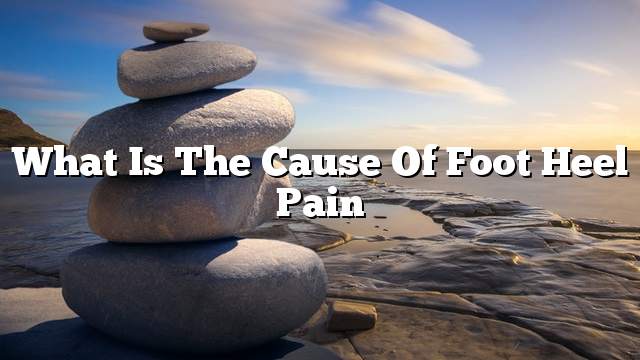Foot heel pain
The heel is the largest of the foot bones. The foot and ankle have 26 bones, 23 joints, and more than 100 tendons. Foot heel pain ranges from mild pain to pain that can cause total foot disability. Pain is usually at the bottom of the heel or in the upper part of the heel. Indicates a serious matter.
Causes of heel heel pain
Foot heel pain is common, which can be due to many reasons. It can be caused by a disease that affects the entire body, such as rheumatoid arthritis or gout, but usually causes pain The heel is topical; none of the heel itself. Common causes of heel pain include:
- Achilles tendonitis: It is the damage to the Achilles tendon that connects the muscles of the hind leg and the heelbone. Achilles tendinitis is common in runners who rapidly reduce or accelerate jogging, and also among middle-aged people who exercise on weekends, such as basketball and tennis.
- Plant fascia: It is the inflammation that affects the tissue at the bottom of the foot, which connects the heel to the toes. Age plays a role in increasing the risk of infection. Plantar fasciitis is also more likely to occur in people whose work requires standing or walking for a long time on solid ground, such as factory workers and teachers. In general, this damage is caused by excessive heel widths; for example by pushing furniture or wearing bad shoes. Some of the other groups that are at risk of contracting plantar fascia are more likely than others:
- Diabetics.
- People with obesity.
- pregnant women.
- Runners.
- Volleyball players and tennis players.
- Spike or nail spike: An abnormal bone growth that occurs in the area where the plant fascia connects to the heel bone and is caused by the continuous stress of plant fascia and foot muscles. It is worth noting that the bone nail (Heel Spur) may not be a cause of heel pain as it may be caused by plantar fascia.
- Sever’s disease: Sever’s disease, also known as Calcaneal Apophysitis, in which the center of the heel bone is exposed to irritation as a result of the wearing of new shoes, or increased sports activity, and the pain is in the top of the heel and not below, and affects the inflammation of children aged 8-14 years, This is due to incomplete growth of the heel bone fully until the age of fourteen; and thus is the most common cause of heel pain in children.
- Bursitis: Bursitis, a sac that extends over joints, helps make muscles and tendons easier to move when the joint moves. The pain is at the top or bottom of the heel bone, and in some cases is caused by problems with the structure of the foot that cause trouble. Walking, and in other cases it may be because of wearing bad shoes.
- Bone growth in the upper region of the heel: Girls are more likely to be infected because they have been associated with bursitis for a long time due to stress caused by wearing high-heeled shoes.
- Exposure to bruising: The heel is bruised like any other part of the foot, and bruises often occur in the form of a bruised bruise, which is caused by a person walking barefoot on sharp objects.
- The heel bone is broken.
- Pressure on the nerve: Stress on the nerves may cause pain, numbness and tingling in the heel area.
When to contact your doctor
You should start with the pain in the heel of the foot to do the domestic procedures to ease the symptoms, and if the pain does not disappear within two to three weeks, then visit the doctor, but in the following cases should contact the doctor immediately:
- If the pain is severe.
- If the pain starts suddenly.
- If the pain of the heel coincides with the presence of fever, or feeling tingling, or numbness.
- If redness, swelling or swelling is observed in the heel area.
- Inability to bend the foot down.
- Inability to walk because of pain.
Treatment of heel heel pain
There are many home remedies that can be done to relieve foot heel pain, including:
- Take a good rest.
- Place snow on the heel area for 10-15 minutes twice a day.
- Take over-the-counter painkillers.
- Pay attention to wearing appropriate shoes.
- Use the night trowel, which helps to tighten the foot and sleep.
If the pain does not improve with these procedures, the doctor will provide the appropriate treatment depending on the cause. The doctor depends on the cause of the pain symptoms and the time it begins. The doctor may require an X-ray of the heel to determine the cause of the pain. In many cases, the doctor uses physical therapy, which helps strengthen the muscles and tendons of the foot to prevent further damage. In severe cases, the doctor describes the patient as anti-inflammatory, which may be in the form of injections, or may be taken orally, and advises the patient to support the foot as much as possible. It is worth mentioning that in some rare cases may be resort to surgery to correct the problem, but it takes a long time to heal, and may not be removed from the pain of the heel always.
